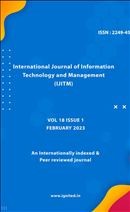The Impact of Financial Inclusion as a tool for Inclusive Development
Main Article Content
Authors
Abstract
The pursuit of financial inclusion in India has a long and storied history. Financial inclusiondescribes the policy of providing low-income people with easy and affordable access to credit and otherfinancial services. The goal of Financial Inclusion is to promote economic growth by making it such thatpeople from all socioeconomic backgrounds have equal access to, use of, and profit from the formalfinancial system. The promotion of economic parity has recently emerged as one of the most pressingissues facing modern society. In India, the concept of financial inclusion presents a challenge since thegreat majority of the population is still denied access to inclusive economic growth. Credit access isincreasingly seen as a tool for economic growth. Consider the effects of financial inclusion on inclusivedevelopment in this paper.
Downloads
Download data is not yet available.
Article Details
Section
Articles
References
- Beck, T., Demirgüç-Kunt, A., & Levine, R. (2017). Finance, Inequality, and Poverty: Cross-Country Evidence. Journal of Economic Growth, 12(1), 27-49.
- Burgess, R., & Pande, R. (2015). Do Rural Banks Matter? Evidence from the Indian Social Banking Experiment. American Economic Review, 95(3), 780-795.
- Cull, R., Demirgüç-Kunt, A., & Morduch, J. (2019). Microfinance Meets the Market. Journal of Economic Perspectives, 23(1), 167-192.
- Honohan, P. (2017). Cross-Country Variation in Household Access to Financial Services. Journal of Banking & Finance, 31(7), 2193-2216.
- Klapper, L., & Panos, G. A. (2021). Financial Literacy and Its Consequences for Individuals and Societies: A Literature Review. World Bank Policy Research Working Paper No. 5798.
- Kuzilwa, J. A. (2018). Financial Inclusion and Development in Africa: An Overview. African Development Review, 24(4), 312-325.
- La Porta, R., Lopez-de-Silanes, F., & Shleifer, A. (2018). The Economic Consequences of Legal Origins. Journal of Economic Literature, 46(2), 285-332.
- Morduch, J. (2022). The Microfinance Promise. Journal of Economic Literature, 37(4), 1569-1614.
- Nair, T. S. (2017). Financial Inclusion as a Tool for Inclusive Development: A Study in Indian Context. International Journal of Scientific Research and Management Studies, 4(9), 54-58.
- Nkusu, M. (2021). Nonperforming Loans and Macrofinancial Vulnerabilities in Advanced Economies. IMF Working Paper WP/11/161.
- Rutherford, S. (2020). The Poor and Their Money. Oxford University Press.
- Sarma, M. (2016). Index of Financial Inclusion - A Measure of Financial Sector Inclusiveness. Munich Personal RePEc Archive Paper No. 36886.
- Sarma, M., & Pais, J. (2021). Financial Inclusion and Development: A Cross-Country Analysis. Journal of International Development, 23(5), 613-631.
- World Bank. (2019). Global Financial Development Report 2014: Financial Inclusion. World Bank Publications.
- Zeller, M., & Sharma, M. (2018). Many Borrowers, Many Outcomes: The Impacts of Microfinance in Bangladesh. The World Bank Economic Review, 15(3), 581-603.
- Klapper, L., & Singer, D. (2015). The Role of Government and Institutions in Financial Inclusion. Journal of Economic Perspectives, 29(3), 63-82.
- World Bank. (2020). Global Findex Database 2017: Measuring Financial Inclusion and the Fintech Revolution. World Bank Publications.
- Demirgüç-Kunt, A., Klapper, L., & Singer, D. (2018). Financial Inclusion and Inclusive Growth: A Review of Recent Empirical Evidence. Policy Research Working Paper No. 8040, World Bank Group.

